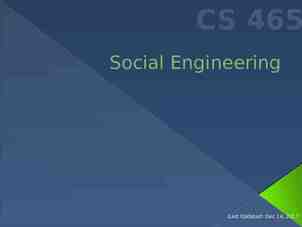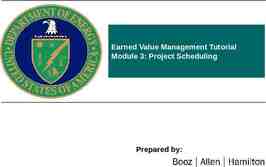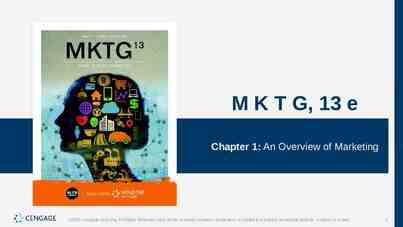Lecture 1 What is AI? CSE 473 Artificial Intelligence Oren Etzioni
23 Slides702.50 KB

Lecture 1 What is AI? CSE 473 Artificial Intelligence Oren Etzioni

AI as Science What are the most fundamental scientific questions? 2

Goals of this Course To teach you the main ideas of AI. Give you AI “color” To introduce you to a set of key techniques and algorithms from AI To introduce you to the applicability and limitations of these methods (problem sets) 3

What is Intelligence? 4

What is Artificial Intelligence? 5

Hardware 1011 neurons 1014 synapses cycle time: 10-3 sec 107 transistors 1010 bits of RAM cycle time: 10-9 sec 6

Computer vs. Brain 7

Conclusion In near future we can have computers with as many processing elements as our brain, but: far fewer interconnections (wires or synapses) much faster updates. Fundamentally different hardware may require fundamentally different algorithms! Very much an open question. Neural net research. 8

What Level of Abstraction? Hardware (build brains) “network” (neural networks?) Algorithm representation Intermediate Behavior (cognitive modeling) Task Performance (Deep Blue, Turing Test) Task Competence (Idealized view) 9

Classical AI The principles of intelligence are separate from any hardware / software / wetware implementation Look for these principles by studying how to perform tasks that require intelligence Can we rely on simple tasks? (e.g., 8-puzzle, tic tac toe) 10

Success Story: Medical Expert Systems Mycin (1980) Expert level performance in diagnosis of blood infections Today: 1,000’s of systems Everything from diagnosing cancer to designing dentures Often outperform doctors in clinical trials Major hurdle today – non-expert part – doctor/machine interaction 11

Success Story: Chess I could feel – I could smell – a new kind of intelligence across the table - Kasparov Examines 5 billion positions / second Intelligent behavior emerges from bruteforce search 12

Autonomous Systems In the 1990’s there was a growing concern that work in classical AI ignored crucial scientific questions: How do we integrate the components of intelligence (e.g. learning & planning)? How does perception interact with reasoning? How does the demand for real-time performance in a complex, changing environment affect the architecture of intelligence? 13

Provide a standard problem where a wide range of technologies can be integrated and examined By 2050, develop a team of fully autonomous humanoid robots that can win against the human world champion team in soccer. 14

Software Robots (softbots) Softbots: ‘intelligent’ program that uses software tools on a person’s behalf. Sensors LS, Google, etc. Effectors RM, ftp, Amazon.com Software: not physical but not simulated. Active: not a help system (softbot safety!) 15

Key Hard Problem for AI Today’s successful AI systems operate in well-defined domains employ narrow, specialize knowledge Commonsense Knowledge needed to operate in messy, complex, open-ended worlds – Your kitchen vs. GM factory floor understand unconstrained Natural Language 16

Role of Knowledge in Natural Language Understanding Speech Recognition “word spotting” feasible today continuous speech – rapid progress turns out that “low level” signal not as ambiguous as we once thought Translation / Understanding very limited progress The spirit is willing but the flesh is weak. (English) The vodka is good but the meat is rotten. (Russian) 17

Syntactic, Semantic, Analogical Knowledge Time flies like an arrow. Fruit flies like a banana. Fruit flies like a rock. 18

How to Get Commonsense? CYC Project (Doug Lenat, Cycorp) Encoding 1,000,000 commonsense facts about the world by hand Coverage still too spotty for use! Alternatives? Open Mind KnowItAll 19

Historical Perspective (4th C BC ) Aristotle, George Boole, Gottlob Frege, Alfred Tarski formalizing the laws of human thought (16th C ) Gerolamo Cardano, Pierre Femat, James Bernoulli, Thomas Bayes formalizing probabilistic reasoning (1950 ) Alan Turing, John von Neumann, Claude Shannon thinking as computation (1956) John McCarthy, Marvin Minsky, Herbert Simon, Allen Newell start of the field of AI 20

Recurrent Themes Neural nets vs AI McCulloch & Pitts 1943 Died out in 1960’s, revived in 1980’s – Neural nets vastly simplified model of real neurons, but still useful & practical – massive parallelism – particular family of learning and representation techniques Logic vs Probability In 1950’s logic seemed more computationally & expressively attractive (McCarthy, Newell) – attempts to extend logic “just a little” to deal with the fact that the world is uncertain! 1988 – Judea Pearl’s work on Bayes nets – provided efficient computational framework Today – no longer rivals – hot topic: combining probability & first-order logic 21

Recurrent Themes, cont. Weak vs Strong Methods Weak – general search methods – A* search, constraint propagation, . Rise of “knowledge intensive” approach – expert systems – more knowledge, less computation Today: resurgence of weak methods – desktop supercomputers – in highly competitive domains (Chess) exceptions to the general rules are most important! How to combine weak and strong methods seamlessly? 22

(Re-)Current Themes Combinatorial Explosion Micro-world successes don’t scale up. How to Organize and accumulate large amounts of knowledge? How to translate from informal, ill-structured statements to formal reasoning (e.g., understand a story)? What are reasonable simplifying assumptions? 23






